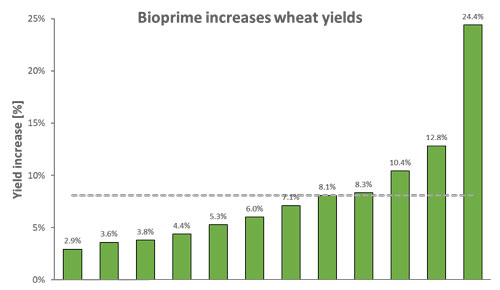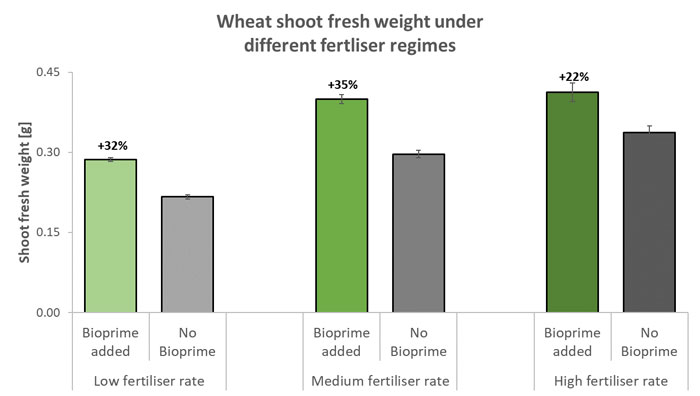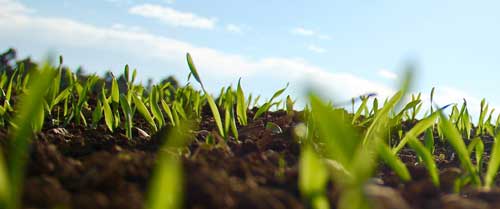Research & Development
Bioscience specialises in contract R&D helping our clients to develop more efficient and sustainable agricultural practices. This has been central to our business for over 25 years and many of our research clients have risen to become industry leaders.
Bioscience is an AusIndustry registered Research Service Provider (#89461) under Section 29A of the Industry Research and Development Act 1986. This means we can help our clients to obtain tax concessions to offset the risks inherent in undertaking R&D.
Bioscience has developed a range of products and technologies from its commitment to R&D. This is demonstrated by the number of patents and the scientific research publications that our staff have co-authored.
R&D Clients
Zaldeesh Pty Ltd
Zaldeesh are one of the largest greenhouse growers in WA, producing premium quality capsicums on a year-round basis. They have more recently expanded to develop premium pomegranate orchards using unique trellis training systems. Zaldessh are partners with Bioscience in patented Biocarb production technology.
Baldivis Farms
Baldavis Farms are a long-established and respected producer of field vegetables, and more recently of greenhouse hydroponic lettuce and herbs. Their research work with Bioscience focusses on production technology which minimises the use of chemical inputs into production of export quality fresh produce.
Berrysweet
Berrysweet produce quality strawberries, raspberries, blackberries and blueberries on a year-round basis from their three sites in Western Australia. They have grown to be the largest Australian berry producer, renowned for producing the sweetest berries money can buy. Their research work with Bioscience focusses on improving production methods, to move towards being chemical-free and to stay industry leaders.
Adelong Farms Pty Ltd
Located at Ravensthorpe in the state’s south, Adelong Farms is a family business producing cereals and sheep. As their business grows and prospers, they work with Bioscience to develop maximum yields while improving soil health by increasing their soil organic carbon levels and microbial biomass.
Southern Spongolite
Southern Spongolite Industries Pty Ltd produce the unusual mineral spongolite (literally fossilised sponges), at Kendenup, in the southwest of WA. Bioscience is undertaking their R&D and has produced ground-breaking technology for which a provisional patent has been filed.
After physical and chemical treatment, spongolite has the capacity to absorb environmental pollutants such as phosphate and nitrate. It is currently being applied to waterways to prevent eutrophication and this helps to keep our environment pristine. This is new technology with an environmental benefit – removing pollutants from the natural environment.
Let us assist your R&D projects with sound advice and management.
R&D Examples
BIOPRIME
Bioprime is a unique soil priming agent that works by changing the soil microbiome. When applied to soil, even in very small amounts, Bioprime changes the diversity within a wide range of important soil microbial groups, promoting the development and diversity of beneficial microbes. The outcome of these changes is a stronger plant, better root growth, and ultimately a more efficient system delivering higher crop yields.
In our commitment to ongoing R&D, we conduct Bioprime trials at different scales: pot trials, small plot trials, field trials , and farm-scale trials. Below are some of the results from our pot trials that test early seedling establishment and growth.
BIOPRIME INCREASES WHEAT SEEDLING EMERGENCE
Bioprime increased emergence of wheat seedlings in a pot trial. The graph shows that under the same fertiliser conditions, Bioprime increased the rate of seedling emergence and the final number if seeds emerged (by %) compared to the control that did not receive Bioprime. A different soil amendment that was also tested in this trial decreased the rate of seedling emergence and the final number if seeds emerged. This was abated by the addition of Bioprime. This means that Bioprime improves germination which can be patchy especially in water-repellent soils.


BIOPRIME INCREASES WHEAT GROWTH
Bioprime significantly (P < 0.001) enhanced the fresh weight of wheat under different fertiliser regimes in a pot trial. In the graph, you can see that Bioprime increased the above-ground wheat biomass by between 22% and 35% compared to the respective control for the same fertiliser application rate (compare paired green and grey columns). More importantly, when comparing the data from the medium fertiliser rate with Bioprime to the high fertiliser rate without Bioprime, the former achieves a significantly higher biomass (+19%, P = 0.01). Equally, when looking at the low fertiliser rate with Bioprime versus the medium fertiliser rate without Bioprime the same amount of biomass was produced. This means that by altering the soil microbiome, Bioprime stimulates plant growth and seedling establishment through better nutrient use efficiency resulting in vigorous plants. Improving the health and vigour of young seedlings should translate into increased crop yields.
FERMENTATION AND FORMULATION TECHNOLOGY
We also continue to improve the fermentation process and trial new formulations of Bioprime to increase the concentrations of active ingredients and to reduce production cost making it more cost-effective for our customers.
INCREASING CROP PRODUCTION WITH BIOPRIME – SOIL MICROBIAL ECOLOGY CONFERENCE, PERTH
BIOCARB
A recent area of research involved multiple years of field trials in partnership with some of the state’s leading growers and resulted in the development of a new patented technology to enhance plant growth. In precisely-managed, high-production growth systems, all nutritional needs of plants are met, and carbon dioxide availability becomes the limiting factor to growth. Our patented technology allows this to be supplied to plant roots in a new, safe, low-cost way, removing a limitation to plant growth and enabling higher yields than was previously possible.
PATENTS
Keating, P.J and Heide J. 2018 Method for decontaminating a liquid AU2018904321
Keating, P.J. 2016. Nutrient system. US20180105475A1.
Keating, P.J. 2013. Fermented soil additive. WO2014082130A1.
Keating, P.J. 1999. Method for recovering pigments from algal cultures. US6805800B1.
Keating, P.J. and M. Dickson. 1989. A method of growing and preserving fungi and bacteria. WO1990015136A1.
PUBLICATIONS
SCIENTIFIC, PEER-REVIEWED PUBLICATIONS THAT OUR STAFF HAVE CO-AUTHORED
(not all of them are publicly available)
AGRICULTURE OR SOIL RESEARCH
Mickan, B., Abbott, L.K., Solaiman, Z.M., Mathes, F., Siddique, K.H.M. and S.N. Jenkins. 2018. Soil disturbance and water stress interact to influence arbuscular mycorrhizal fungi, rhizosphere bacteria and potential for N and C cycling in an agricultural soil. Biology and Fertility of Soils. https://link.springer.com/article/10.1007%2Fs00374-018-1328-z
Pham, V.T.H., Murugaraj, P., Mathes, F., Tan, B.K., Truong, V.H., Murphy, D.V. and D.E. Mainwaring. 2017. Copolymers enhance selective bacterial community colonization for potential root zone applications. Scientific Reports 7, 15902. https://doi.org/10.1038/s41598-017-16253-0
Lowe, M.A., McGrath, G., Mathes, F. and M. Leopold. 2017. Evaluation of surfactant effectiveness on water repellent soils using electrical resistivity tomography. Agricultural Water Management 181: 56-65. https://doi.org/10.1016/j.agwat.2016.11.013
Gleeson, D.B., Mathes, F., Farrell, M. and M. Leopold. 2016. Environmental drivers of soil microbial community structure and function at the Avon River Critical Zone Observatory. Science of The Total Environment 571: 1407-1448. https://doi.org/10.1016/j.scitotenv.2016.05.185
AQUACULTURE RESEARCH
Jackson, A.N., McLure, C.A., Dawkins, R.L. and P.J. Keating. 2007. Mannose binding lectin (MBL) copy number polymorphism in Zebrafish (D. rerio) and identification of haplotypes resistant to L. anguillarum. Immunogenetics 59: 861-872. https://link.springer.com/article/10.1007%2Fs00251-007-0251-5
MEDICAL RESEARCH
McLure, C.A., Hinchliffe, P., Lester, S., Williamson, J.F., Millman, J.A., Keating, P.J., Stewart, B.J. and R.L. Dawkins. 2013. Genomic evolution and polymorphism: segmental duplications and haplotypes at 108 regions on 21 chromosomes. Genomics 102: 15-26. https://doi.org/10.1016/j.ygeno.2013.02.011
Williamson, J.F., McLure, C.A., Baird, P.N., Male, D., Millman, J., Lawley, B., Ashdown, M.L., Keating, P.J. and R.L. Dawkins. 2008. Human Immunology 69: 207-2019. https://doi.org/10.1016/j.humimm.2008.01.016
McLure, C.A., Williamson, J.F., Stewart, B.J., Keating, P.J. and R.L. Dawkins. 2005. Indels and imperfect duplication have driven the evolution of human Complement Receptor 1 (CR1) and CR1-like from their precursor CR1 alpha: Importance of functional sets. Human Immunology 66: 258-273. https://doi.org/10.1016/j.humimm.2005.01.004
McLure, C.A., Williamson, J.F., Smyth, L.A., Agrawal, S., Lester, S., Millman, J.A., Keating, P.J., Stewart, B.J. and R.L. Dawkins. 2005. Extensive genomic and functional polymorphism of the complement control proteins. Immunogenetics: 57: 805-815. https://link.springer.com/article/10.1007%2Fs00251-005-0049-2
McLure, C.A., Williamson, J.F., Stewart, B.J., Keating, P.J. and R.L. Dawkins. 2004. Genomic analysis reveals a duplication of eight rather than seven short consensus repeats in primate CR1 and CR1L: evidence for an additional set shared between CR1 and CR2. Immunogenetics 56: 631-638. https://link.springer.com/article/10.1007%2Fs00251-004-0731-9
Harvey, A.R., Rush, R.A. and P.J. Keating 1988. Cultured fetal tectal tissue grafted to the midbrain of newborn rats: morphology of grafts and innervation by host retinal and cortical axons. Brain Research 462: 89-98. https://doi.org/10.1016/0006-8993(88)90589-6
INDUSTRY PUBLICATIONS / REPORTS
(all available online)
AGRICULTURE OR SOIL-RELATED REPORTS
Keating, P.J. and F. Mathes. 2018. The effect of dung and dung beetle (Bubas bison) activity on soil microbial communities. https://www.dungbeetlessouthwest.org.au/copy-of-introducing-dung-beetles
Keating, P.J. and F. Mathes. 2016. Bioprime: Impact on wheat production. https://www.farmtrials.com.au/trial/18663?search_num=2
Keating, P.J. 2014. Bioprime: Impact on Yield, Soil Carbon Accumulation and Nitrogen Use. https://www.farmtrials.com.au/trial/19106?search_num=2
Keating, P.J. 2005. Understanding the use of chicken manure in vegetable production on sandy soil. Horticulture Australia Limited. Project VG00006. https://ausveg.com.au/app/data/technical-insights/docs/VG00006%20using%20chicken%20manure%20in%20veg%20production.pdf
Mathes F., Murugaral, P., Bougoure, J., Pham, V.T.H., Truong, V.K., Seufert, Wissemeier, A.H., Mainwaring, D.E., and Murphy, D.V. 2020. Engineering rhizobacterial community resilience with mannose nanofibril hydrogels towards maintaining grain production under drying climate stress. Soil Biology and Biochemistry 142: 107715. https://doi.org/10.1016/j.soilbio.2020.107715
Lowe, M.-A., Mathes, F., Loke, M.H., McGrath, G., Murphy, D.V., Leopold, M. 2019. Bacillus subtilis and surfactant amendments for the breakdown of soil water repellency in a sandy soil. Geoderma 344: 108-118. https://doi.org/10.1016/j.geoderma.2019.02.038
O’Brien F.J.M., Almaraz M., Foster M.A., Hill A.F., Huber D.P., King E.K., Langford H., Lowe M.-A., Mickan B.S., Miller V.S., Moore O.W., Mathes F., Gleeson D. and M. Leopold. 2019. Soil Salinity and pH Drive Soil Bacterial Community Composition and Diversity Along a Lateritic Slope in the Avon River Critical Zone Observatory, Western Australia. Frontiers in Microbiology 10: 1486. https://doi.org/10.3389/fmicb.2019.01486
Vithana, M.D.K., Singh, Z., and S.K. Johnson. 2019. Regulation of health-promoting compounds in mango fruit: a review. Journal of the Science of Food and Agriculture 99: 3740-3751. https://doi.org/10.1002/jsfa.9628
Vithana, M.D.K., Singh, Z., and S.K. Johnson. 2019. Harvest maturity stage affects the concentrations of health-promoting compounds: lupeol, mangiferin and phenolic acids in the pulp and peel of ripe ‘Kensington Pride’ mango fruit. Scientia Horticulturae. 243, 125 – 130. https://doi.org/10.1016/j.scienta.2018.08.019
Vithana, M.D.K., Singh, Z., and S.K. Johnson. 2018. Concentrations of health-promoting phytochemicals in ripe mango fruit triggered by postharvest application of elicitors. Journal of the Science of Food and Agriculture. DOI: 10.1002/jsfa.9280. https://doi.org/10.1002/jsfa.9280
Vithana, M.D.K., Singh, Z. and S.K. Johnson. 2018. Cold storage temperatures and durations affect the concentrations of lupeol, mangiferin, phenolic acids and other health-promoting compounds in the pulp and peel of ripe mango fruit. Postharvest Biology and Technology 139: 91-98. https://doi.org/10.1016/j.postharvbio.2017.12.003
Vithana, M.D.K., Singh, Z. and S.K. Johnson. 2018. Dynamics in the concentrations of health-promoting compounds: lupeol, mangiferin and different phenolic acids during postharvest ripening of mango fruit. Journal of the Science of Food and Agriculture 98: 1460-1468. https://doi.org/10.1002/jsfa.8614
Vithana, M.D.K., Singh, Z. and S.K. Johnson. 2018. Levels of terpenoids, mangiferin and phenolic acids in the pulp and peel of ripe mango fruit influenced by pre-harvest application of FeSO4 (Fe2+), MgSO4 (Mg2+) and MnSO4 (Mn2+). Food Chemistry: 256: 71-76. https://doi.org/10.1016/j.foodchem.2018.02.087

